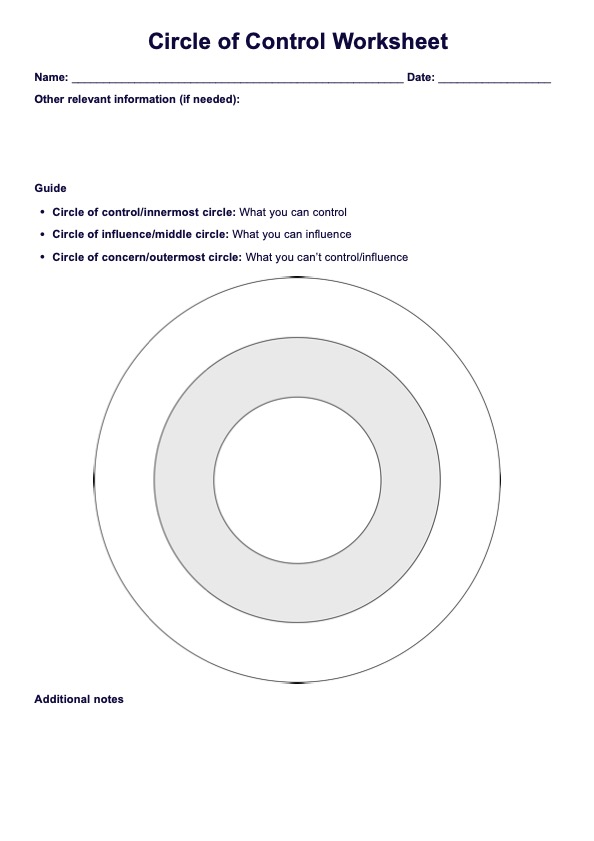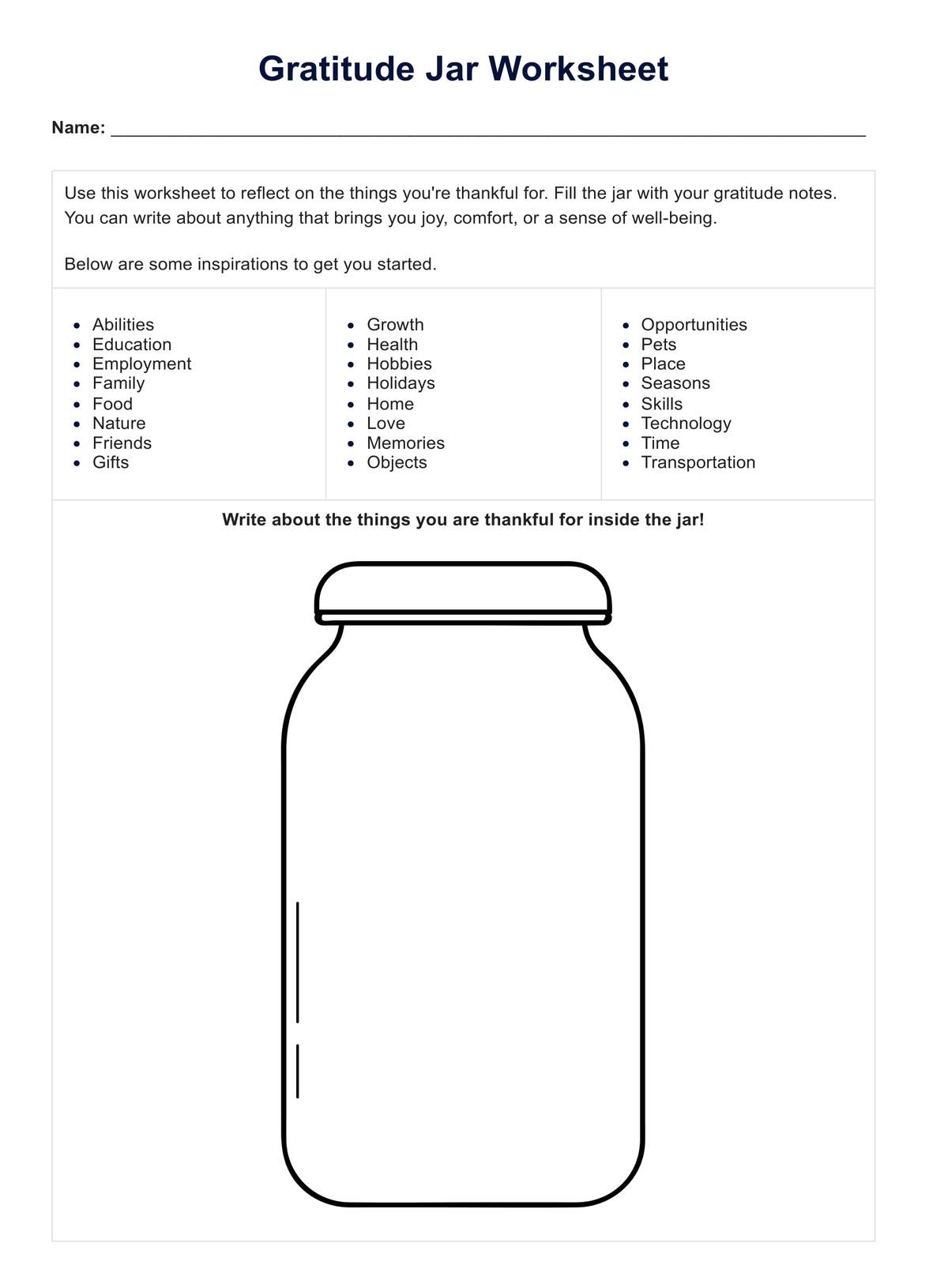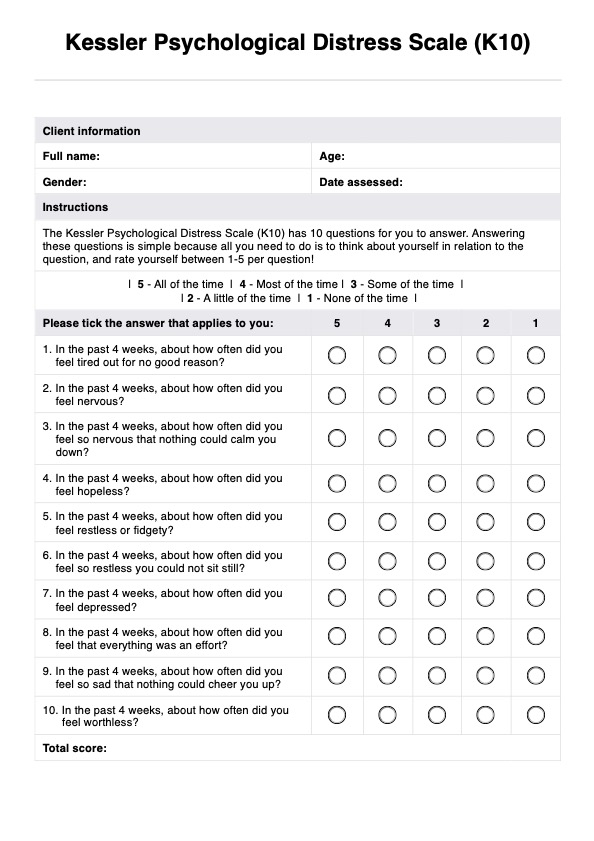Psychosis Spectrum Test
Discover if you are at risk of psychosis with the Psychosis Spectrum Test. Assess symptoms, gain insights, and find support. Take the test now!


What is a Psychosis Spectrum Test?
The Psychosis Spectrum Test refers to a psychological assessment tool designed to identify symptoms and signs that may fall within the psychosis spectrum. The psychosis spectrum encompasses a range of mental health conditions characterized by alterations in one's perception of reality and can include disorders like schizophrenia, schizoaffective disorder, and bipolar disorder with psychotic features.
Key aspects of such tests include:
- Screening for psychotic symptoms: The test often screens for both positive symptoms (like hallucinations, delusions, and incoherent speech) and negative symptoms (like social withdrawal, flat affect, and reduced emotional expression).
- Assessing risk of psychotic disorders: For individuals at ultra-high risk or in the prodromal phase of psychotic disorders, these tests can help in early identification and intervention.
- Diagnostic criteria: These tests often align with the criteria set forth in the Diagnostic and Statistical Manual of Mental Disorders (DSM) by the American Psychiatric Association, ensuring they cover the key diagnostic elements of various psychotic disorders.
- Evaluation of functional impact: They may assess how potential psychotic symptoms impact daily living, social relationships, and overall functioning.
- Comprehensive approach: The test might include questions about mood episodes, substance use disorder, and other factors that can influence mental health, such as ambiguous environmental cues and stressors.
- Professional interpretation: Results from a psychosis spectrum test usually require further evaluation by a qualified mental health professional to ensure a proper diagnosis and to discuss treatment options.
- Guiding treatment and support: Depending on the outcome, the test can guide healthcare providers in recommending talk therapy, early intervention strategies, and other treatment options to help individuals lead a more fulfilling life despite their challenges.
It's important to note that such tests are tools for screening and not definitive diagnostic instruments. A full evaluation by a mental health professional is essential for an accurate diagnosis and to determine the best course of treatment.
Symptoms of psychosis
Before we begin, it is important to recognize the most common symptoms of a psychosis episode. Psychosis can present differently in everyone. However, psychosis typically presents as one of the following:
- Delusions
- Hallucinations
- Disorganized thought
- Disorganised behaviour
- Negative symptoms
Psychosis Spectrum Test Template
Psychosis Spectrum Test Example
How does it work?
Here are the instructions for using the Psychosis Spectrum Test:
Step 1: Introduction
Introduce the test's purpose, emphasizing that it aims to assess an individual's risk of experiencing psychosis. Mention that it is designed to be completed by the individual themselves and interpreted by qualified professionals.
Step 2: Provide clear instructions
Clearly explain how to use the test, including the frequency scale and the meaning of each rating (1-5). Individuals should rate each statement based on how frequently they experience the described phenomenon.
Step 3: Test completion
Instruct individuals to review each statement and select the appropriate rating reflecting their experiences. Emphasize the importance of answering honestly and to the best of their ability.
Step 4: Scoring
Explain that after completing the test, individuals should tally up their scores by adding the ratings for each statement. Reinforce that higher scores may indicate a higher risk of psychosis.
Step 5: Interpretation and recommendations
Clarify that interpretation of results should be done by qualified healthcare professionals or mental health specialists. Mention the three risk categories: Low, Moderate, and High. Briefly describe each category, highlighting the need for further evaluation and appropriate support based on the results.
Step 6: Additional information
A reminder that the test is not a definitive diagnosis and should not replace a professional evaluation. Encourage individuals to seek professional help if they have concerns about their mental health or are experiencing distressing symptoms.
Step 7: Printable version
Mention the availability of a printable version of the Psychosis Spectrum Test, indicating that it can be used as a physical handout or shared as a digital document.
Disclaimer
The test is for informational purposes only and should not be used as a sole basis for diagnosis or treatment. Individuals should consult a qualified healthcare professional for accurate assessment and appropriate recommendations.
When would you use this template?
The Psychosis Spectrum Test template can be used when assessing an individual's risk of psychosis is relevant. Here are some instances when this resource can be appropriately utilized:
Mental health screenings
The template can be employed as part of routine mental health screenings in healthcare settings, clinics, or hospitals. It provides a structured approach to evaluate individuals' potential risk of psychosis, aiding in early detection and intervention.
Community outreach programs
Mental health awareness campaigns, community centers, or organizations focused on mental well-being can utilize this template to provide an initial assessment for individuals concerned about their mental health or experiencing distressing symptoms.
Educational settings
Schools, colleges, and universities can utilize the template as a part of mental health awareness programs or as a resource for students to self-assess their mental well-being. It can help identify students who may require additional support or referrals to mental health professionals.
Research studies
The template can be used in research studies investigating psychosis risk factors, prevalence, or treatment outcomes. Researchers can gather valuable data by administering the test to participants and analyzing the results to gain insights into the population under study.
Telehealth services
With the increasing popularity of telehealth services, the template can be integrated into online platforms or mobile applications to provide remote mental health assessments. It enables individuals to conveniently access the test, assess their risk, and receive appropriate recommendations.
Benefits
Using the Psychosis Spectrum Test template offers several benefits:
Early detection
The template enables the early detection of potential psychosis risk factors. By identifying symptoms and risk indicators, individuals can seek timely intervention, leading to improved outcomes and better management of the condition.
Self-assessment
The test allows individuals to self-assess their mental health in a structured manner. It promotes self-awareness and empowers individuals to recognize concerning symptoms, facilitating open discussions with healthcare professionals.
Accessibility
The template provides a free and easily accessible resource for individuals to assess their risk of psychosis. It can be shared digitally, printed, or integrated into online platforms, making it widely available in healthcare settings, educational institutions, and community programs.
Privacy and confidentiality
The template respects individuals' privacy and confidentiality. It allows them to complete the test confidentially, ensuring their responses remain secure and confidential, encouraging openness and honesty in their answers.
Guidance and referrals
The template is a valuable tool for healthcare practitioners to guide individuals toward appropriate support services. Based on the results, healthcare professionals can provide referrals for further evaluation and connect individuals with the necessary resources and treatment options.
Research and data collection
The template can aid research studies on understanding psychosis and related disorders. Researchers can gather valuable data by administering the test to participants, contributing to advancing knowledge in the field.

You can also use this Clinical Evaluation template to streamline the process of assessing patient health and identifying treatment needs. This template facilitates detailed documentation and enhances the overall evaluation process.
Research & evidence
The Psychosis Spectrum Test (PST) is a self-report questionnaire developed to assess the likelihood of a person having a psychosis-spectrum disorder. The PST was first published in 2005 by John M. Kane, M.D., and colleagues at the University of California, San Francisco. The test is based on the Diagnostic and Statistical Manual of Mental Disorders (DSM-IV-TR), the standard diagnostic manual for mental disorders.
The PST has been used in several research studies, and the results have shown that it is a reliable and valid tool for assessing psychosis-spectrum disorders. For example, a study published in the journal Schizophrenia Bulletin in 2008 found that PST correctly identified people with psychosis-spectrum disorders with an accuracy of 85%.
The PST is a useful tool for clinicians and researchers interested in assessing the risk of psychosis. However, it is essential to note that PST is not a diagnostic tool. If you are concerned that you may have a psychosis-spectrum disorder, it is important to see a doctor for a clinical evaluation.
References
Kane, J. M., Honer, W. G., et al. (2005). The Psychosis Spectrum Test: A self-report scale for assessing the risk of psychosis. Schizophrenia Bulletin, 31(3), 643-656. doi:10.1093/schbul/sbi021
Morgan, C. M., et al. (2008). The Psychosis Spectrum Test: A validation study. Schizophrenia Bulletin, 34(4), 861-867. doi:10.1093/schbul/smn038
National Institute of Mental Health. (2017). Understanding psychosis. Retrieved from https://www.nimh.nih.gov/health/publications/understanding-psychosis
National Alliance on Mental Illness. (2023, January 24). Psychosis screening tool. Retrieved June 22, 2023, from https://screening.mhanational.org/screening-tools/psychosis/
Patel, V., Araya, R., & Saha, S. (2020). Psychosis: A global public health challenge. The Lancet, 395(10225), 941-959. doi:10.1016/S0140-6736(20)30402-1
Thames Health Partners. (n.d.). Psychosis spectrum clinic. Retrieved June 22, 2023, from https://www.thp.ca/patientservices/mentalhealth/ambulatoryCareOutpatientServices/communitylivingsupports/Pages/Psychosis-Spectrum-Clinic.aspx
The Recovery Village. (2023, January 20). Do I have a psychotic disorder? Retrieved June 22, 2023, from https://www.therecoveryvillage.com/mental-health/psychosis/do-i-have-a-psychotic-disorder/
Woods, S. J., Morrison, A. P., & Van Os, J. (2021). Psychotic experiences: A public mental health perspective. Psychological Medicine, 51(11), 1975-1987. doi:10.1017/S0033291721001156
Commonly asked questions
No, the Psychosis Spectrum Test is not a diagnostic tool. It indicates potential risk factors for psychosis and helps determine the need for further evaluation by a healthcare professional.
If your results suggest a high risk, seeking immediate help from a qualified healthcare professional is essential. They can provide a comprehensive evaluation, offer appropriate interventions, and connect you with necessary support services.
The Psychosis Spectrum Test can be used as a starting point to assess your risk at a particular point in time. However, it is not designed for continuous monitoring. Regular check-ins with a healthcare professional are recommended for ongoing evaluation.
Individuals of various ages can take the test. However, specific versions may exist for different age groups, so choosing the appropriate version based on age and developmental stage is essential.


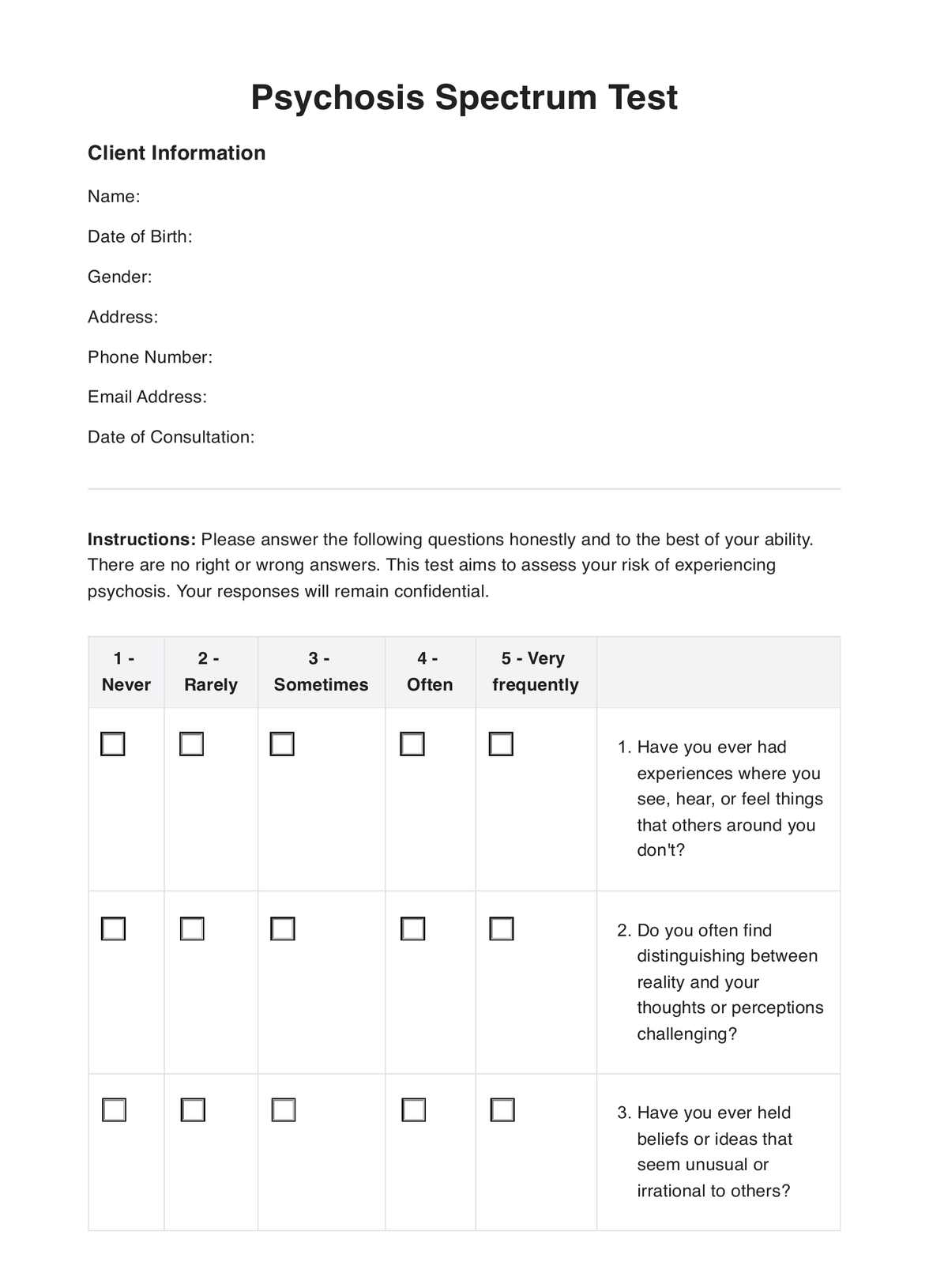
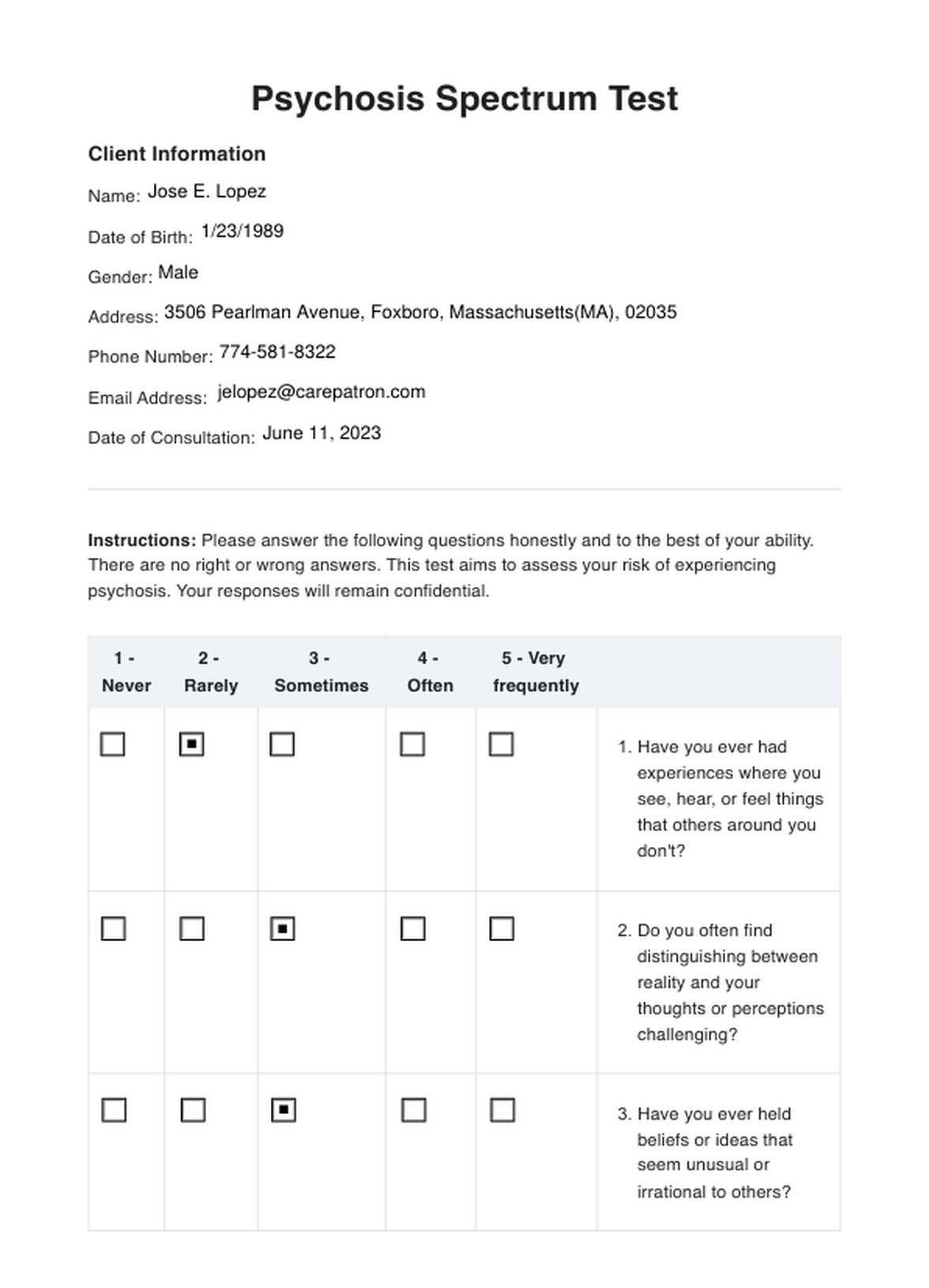

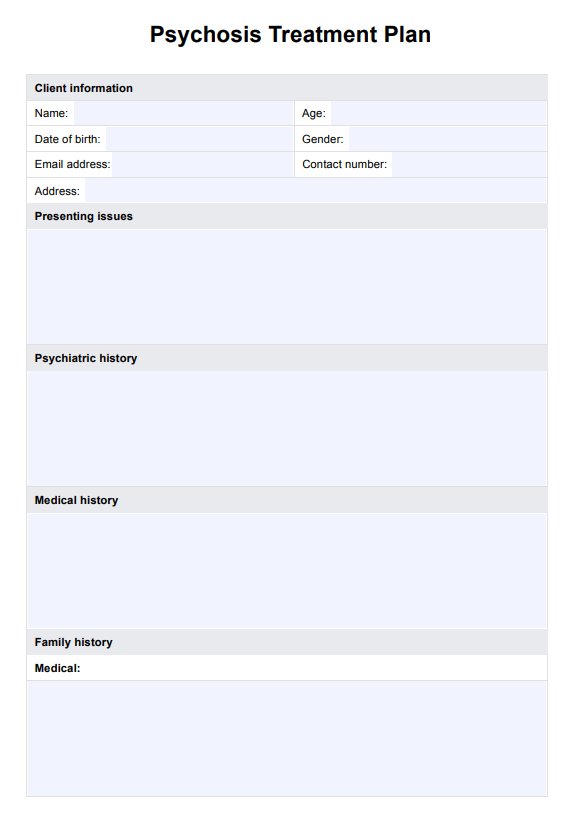














-template.jpg)





















































































